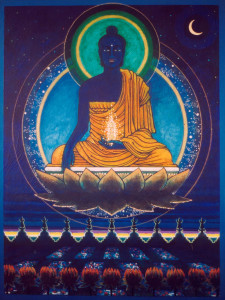Imagine for a moment that we’ve jumped-ahead to the later Bardo experiences; this is the end of life, the signs of imminent death are creeping all around us. Our bodily shell (rupakaya) is deteriorating fast—that’s the sign-post up ahead…the Bardo of Dharmatā is coming soon! Then, for a brief interval, the Clear Light of the Dharmakaya is there beckoning us to its effervescent shore. The way home is shining all around us. But wait! Lacking the proper gnosis, we fail to recognize this supreme window of opportunity; the body consciousness still clings to life…panting…grasping…trying desperately to maintain control over the vicissitude’s of its dictatorial hold over all cognitive functions. The moment is wasted. The window slams shut! We are left alone again with those meandering thoughts that in the bardo-proper become manifested and magnified beyond description. We are once again entrapped in that monstrous maze whose diurnal course leads to another womb-birth in one of the six realms of samsaric existence. Mea Culpa! All is lost! That’s why prior effort spent in Bardo Realm Three of meditation and Deep Samadhis was so critical in avoiding and transcending this unhappy fault! Entering into the Transformational Mandala of the Five Tathagatas is a prerequisite for abstaining from the erratic course of the body consciousness and its nefarious crew, the five skandhas.
When entering into the Meditational and Transformational Mandala of the Five Tathagatas, one needs to circumambulate round its sacred-center by meditating on the Four Tathagatas that orbit-round Vairocana’s Dharmachakra—his Sacred Eight-Spoked Wheel. The first-stop round the Wheel is the Eastern Pure-Land Realm of Akshobhya. When entering this Buddha-land one is first struck by the radiant blue-hue that seems to permeate everywhere; assuring an ineffable tranquility. There is no mistake about it. We have entered into an “Immovable (like the vast blue heavens) Realm” wherein even the darkest corners of the Alaya vijnana are drawn out and transmuted into the Clear Light and Heart of the Dharmakaya. Nothing is lacking. The pure-emptiness (void of any adventitious defilement) of the Totality Itself is like gazing into a Mirror wherein the Real looks at the Real and No-thing else. Yet, within this sacred-space there is also fluidity, like the flow of a gentle-rivulet; thoughts of hatred and anger just “flow-downstream” as it were and dissolve into that pure-emptiness. All vijnanic activity is now cessated. Just stay—no-thing more need be done. Akshobhya’s Pure-Land is inhabited with members of the Vajra-Family, whose stubborn resilience in the face of all evil is diamond-sharp and strikes at the very heart of Mara himself like a thunderbolt from the sky. This resiliency is reminiscent of Siddhartha Gautama sitting unmovable beneath the Bodhi-tree when Mara tried to uproot his Recollective Resolve with every conceivable disturbance. Shakyamuni remained steadfast in his resolve; as a symbolic gesture, he reached down and gently touched the earth with his right hand—the Sacred Mudra of Akshobhya. In meditation, one becomes One with this Mudra as the symbolic gesture is replicated within oneself; this need not be done exclusively externally and in a sitting posture, but indeed “inwardly” at will, wherever one is. This is all pure-organic stuff, thoroughly transcending the rationalistic mind-set. It’s been said that the tips of Akshobhya’s “Vajra” encompasses both samsara and nirvanic realms; this is also reminiscent of that hermetic formula we encountered in our Primordial Qigong exercise #10 (Heaven and Earth Open and Close), “as above, so below”. Indeed, with this sacred Vajra one slices through all relative-alayic-phenomena and pierces straight to the Immaculate Heart of Suchness –the Amala vijnana; hence, the Skandha of the Body Consciousness is transmuted through the “turn-about in the deepest seat (Amala) of consciousness”. The corresponding chakra here is non-other than the “Heart Chakra” (or the Self Chakra as seen in Light of the Unborn). It is good to meditate gently chanting Akshobhya’s mantra, Om Akshobhya Hūm, while simultaneously entering his mudra:


